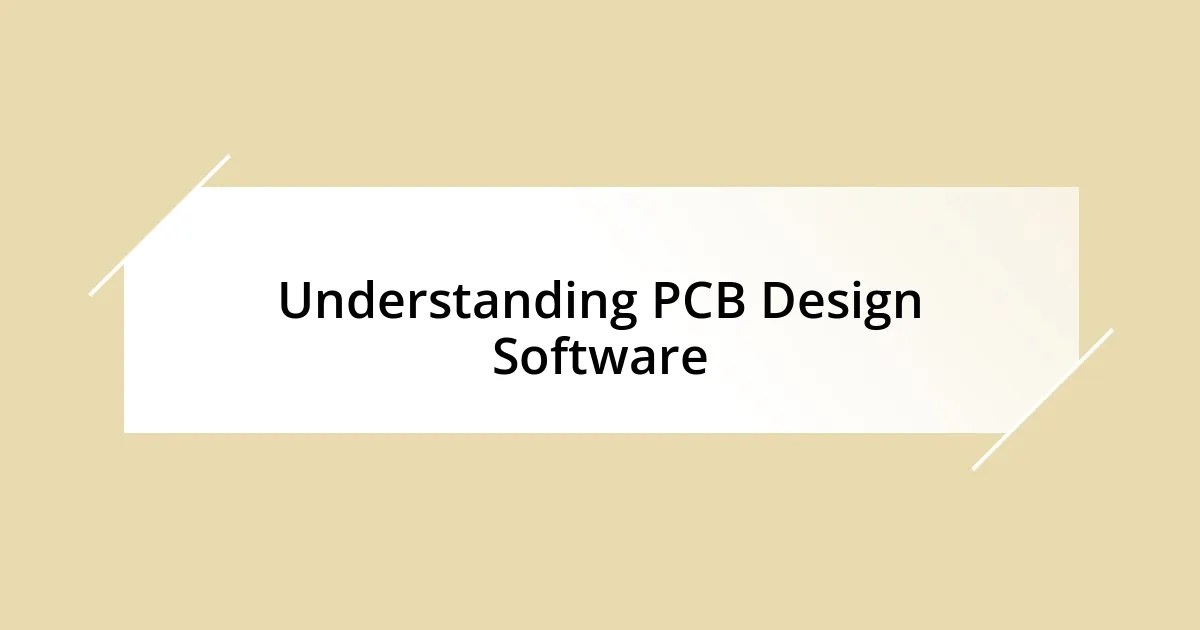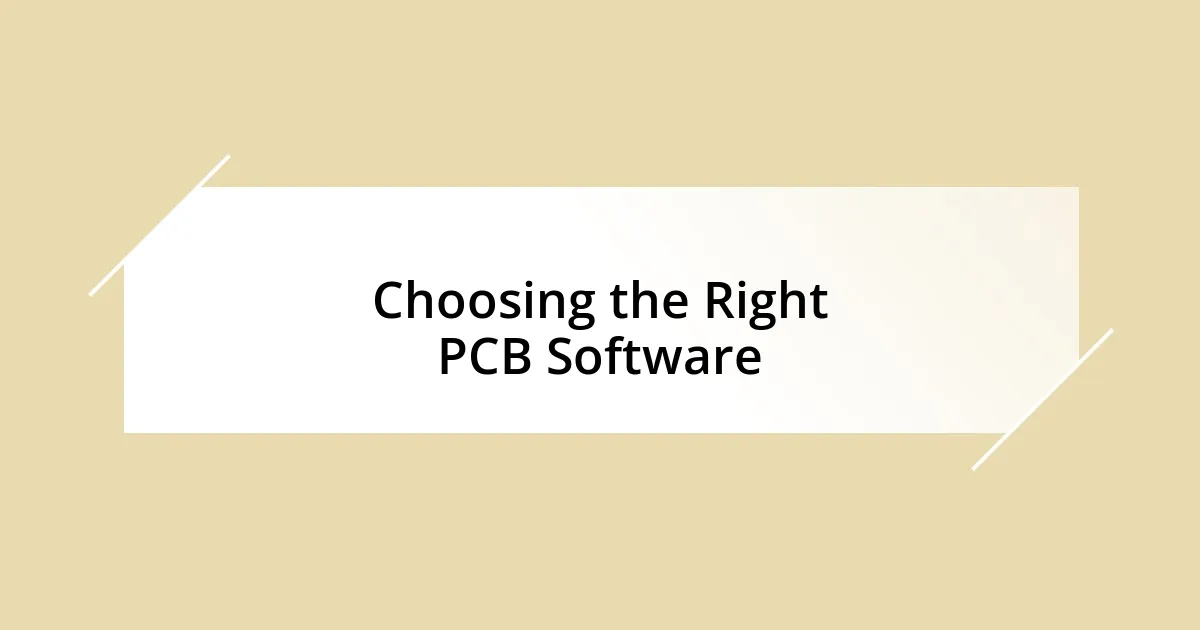Key takeaways:
- Understanding and organizing PCB design software is crucial for effective project management, including mastering layer management to avoid merging critical signal tracks.
- Choosing the right PCB software should align with individual workflow and project needs, prioritizing features like simulation tools and compatibility with existing tools.
- A well-organized workspace enhances efficiency and creativity; personalizing layouts, color coding, and ensuring hardware meets software demands are key strategies.
- Common mistakes in PCB design include ignoring power and ground plane definitions, neglecting component labeling, and lacking version control, all of which can lead to significant troubleshooting challenges.

Understanding PCB Design Software
Understanding PCB design software can feel overwhelming at first, but I remember my own journey into this world. I vividly recall staring at a blank screen filled with countless tools, wondering where to start. It feels like standing on the edge of a vast ocean, right? The software offers a wide range of capabilities, from schematic capture to layout design, allowing for meticulous attention to detail in every project.
When working with these tools, I learned that understanding the interface is crucial. For example, the importance of layers became clear during my first project, where I inadvertently merged critical signal tracks, causing a headache down the line. Have you experienced a situation like that? Diving into layer management not only helps in organizing components but also in avoiding future pitfalls—a lesson I won’t soon forget.
Each PCB design software has its strengths and weaknesses. Some might be great for beginners, offering user-friendly features, while others are geared toward advanced users with complex functions. My preference has shifted as my skills have grown; initially, I leaned heavily on intuitive software, but now I appreciate the versatility of more robust platforms. What about you? It’s fascinating how our needs evolve as our understanding deepens in this intricate field.

Choosing the Right PCB Software
Choosing the right PCB software can feel like navigating a maze. When I first started out, I was drawn to programs that promised ease of use, but over time, I realized that this was only one piece of the puzzle. I remember my excitement when I discovered a more complex software that unlocked features I didn’t even know I needed, which fundamentally changed how I approached my projects.
It’s essential to consider not just the software’s capabilities, but also your own workflow and project needs. There was a time when I chose a software purely based on market popularity, only to find that it did not fit my design style. I learned to prioritize elements such as simulation tools or library management, which significantly enhanced my ability to troubleshoot and innovate. Reflecting on this, I often ask myself: what will truly elevate my work?
Moreover, compatibility with existing tools and hardware should never be overlooked. I recall a project where I faced compatibility issues that delayed everything; it was frustrating. Selecting software that integrates well with your current environment can be a game-changer, making your design process smoother and more efficient. This is not just about finding a tool; it’s about ensuring that it fits harmoniously into your overall toolkit.
| Software | User Level |
|---|---|
| Eagle | Beginner |
| Altium Designer | Advanced |
| KiCad | Intermediate |
| Fusion 360 | Beginner to Intermediate |

Setting Up Your Workspace
When it comes to setting up your workspace for PCB design, I can’t stress enough the importance of an organized environment. My initial experience was a chaotic whirlwind, with tools scattered across the screen and distractions everywhere. It was like trying to assemble a puzzle with pieces flipped upside down! Establishing a tidy digital workspace not only boosts efficiency but also fosters creativity.
To achieve this, consider the following steps:
- Personalize Your Layout: Adjust toolbars and menus to prioritize the features you use most often.
- Create Dedicated Areas: Use separate screens or virtual desktops for schematics, layouts, and documentation.
- Color Coding: Assign colors to different layers or components to instantly recognize them at a glance.
- Limit Distractions: Turn off unnecessary notifications to maintain focus during your workflow.
- Backup Regularly: Set up an automatic backup system to protect your work, alleviating anxiety over potential data loss.
Another vital aspect of workspace setup is ensuring that your hardware complements your software. I remember working on a complex design with a mediocre laptop that left me frustrated due to slow rendering times and constant crashes. It taught me the hard way that having sufficient RAM and a good graphics card can make a world of difference. Planning your hardware to meet the software’s demands not only enhances productivity but significantly reduces the stress of technical hiccups.
Consider these hardware guidelines:
- RAM Requirement: Aim for at least 16GB for smooth multitasking.
- Display: Investing in dual monitors can greatly enhance your workflow and organization.
- Mouse and Keyboard: Use ergonomic options to prevent long-term strain during extended design sessions.
- Cooling Systems: Ensure your system doesn’t overheat during intensive tasks—overheating can lead to crashes.

Tips for Effective PCB Design
When it comes to effective PCB design, one of my best tips is to meticulously plan your layout. I recall a project where I rushed this step, thinking I could just tweak things later. That approach backfired. The final design felt cramped and cluttered, leading to multiple revisions and headaches. Taking the time to sketch out your design on paper or using a simple software guide before jumping in can save you a ton of effort later on. Have you ever faced a similar dilemma?
Another crucial aspect I’ve learned is the importance of component placement. Initially, I didn’t give this much thought. However, I soon discovered that thoughtful positioning can greatly influence the performance of your PCB, especially concerning signal integrity and thermal management. For instance, keeping high-frequency components away from noisy power sources became a game changer for me. It’s fascinating how a small change in placement can enhance functionality—have you ever experienced this revelation?
Lastly, always prioritize design rule checks (DRC) during your workflow. I can’t tell you how many times I overlooked this step early in my career. I vividly remember submitting a design that ultimately failed in the prototype stage due to simple rule violations. That experience taught me to integrate DRC as a non-negotiable part of my process. Trust me, taking a moment to run these checks can save you from a world of frustration down the line. How about you—do you regularly incorporate DRC into your designs?

Common Mistakes to Avoid
One common mistake I see often in PCB design is the failure to properly define the power and ground planes early in the design process. I remember once diving into a project without giving these planes the attention they needed. The result? Poor signal integrity and a circuit that performed erratically. It taught me the hard way that dedicating time upfront to shape the power distribution can prevent headaches further down the road. Have you experienced similar issues with unexpected behavior in your circuits?
Another pitfall I’ve encountered is neglecting to label components clearly in the schematic. Initially, I thought this was a trivial detail until I faced a huge mix-up trying to troubleshoot a circuit that had no clear identifiers. The frustration was palpable, and it hit me how essential clear labeling is—not just for myself, but for anyone who might work on the board later. It’s a small step that saves a lot of time and confusion. Do you take the time to label components meticulously?
Lastly, I must stress the importance of version control. I learned this lesson the hard way when I realized I had made several critical updates to the wrong file. The panic of realizing I lost vital changes was enough to make my skin crawl! Implementing a versioning system or naming convention for files helped me regain control over my work. Ever had a moment where you wished you’d kept better track of your revisions? It’s these little strategies that can make a significant difference in your PCB design journey.














